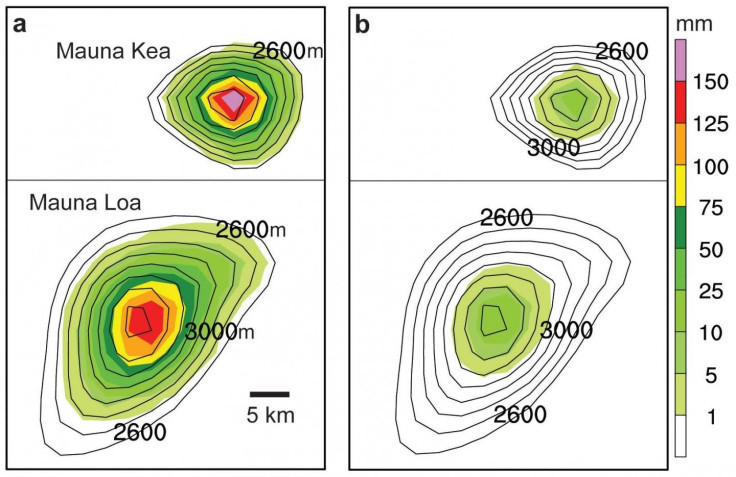Snow In Hawaii, On Mauna Kea And Mauna Loa, Could Almost Disappear By End Of Century
When most people think of Hawaii, snow isn’t exactly the first thing that comes to mind. But amid the tropical beaches, the sun and the sand, tiki cocktails, and the world’s most active volcanoes, there are two mountain peaks that are covered in snow for at least 20 days every winter.
A climate model developed by a group of researchers, published Thursday in an open-access journal, predicts the snowfall Hawaii will likely receive in the future, and shows the Mauna Kea and Mauna Loa volcano summits could lose their snow cover almost entirely by the end of the current century.
Read: How And When Did Hawaii Get Its Vocanoes?
Chunxi Zhang from the International Pacific Research Center at the University of Hawaiʻi at Mānoa, and two other researchers, quantified recent snow cover patterns on the two peaks, using satellite data of surface composition from 2000 to 2015, and created a daily index of snow cover.
Based on global climate projections that included multiple scenarios of anticipated climate change, they compiled a regional climate model. That model was then simulated for the end of the century, assuming greenhouse gas emissions under a moderate business-as-usual scenario.
And the projections showed average winter snowfall would reduce to less than a tenth of current amounts, leading to almost all snow disappearing from the Hawaiian peaks.
“We recognized that Hawaiian snow has an aesthetic and recreational value, as well as a cultural significance, for residents and visitors,” Zhang explained in a statement on the university’s website. “So, we decided to examine just what the implications of future climate change would be for future snowfall in Hawaiʻi.”
The projections didn’t come as much of a surprise, however, since climate models show air temperature rises more at higher altitudes compared to air at sea level. Future climate projections also predict fewer winter storm systems hitting the Pacific island state. Consequently, residents and tourists could potentially lose the chance to see white-capped mountains in Hawaii, brief as the sight maybe.

The two highest peaks in Hawaii are both volcanoes. Mauna Kea, the taller of the two and dormant, stands 4,207 meters (12,802 feet) high, while Mauna Loa, an active volcano which is perhaps the world’s largest, is 4,169 meters.
The volcanoes of Hawaii exist along two sub-parallel tracks that formed about 3 million years ago, when the underlying Pacific tectonic plate changed its direction. Hawaiian volcanoes are the younger, southeastern edge of the chain of volcanoes and submerged seamounts that get older moving northwest.
The method used by the researchers to establish the snow cover on the Hawaiian mountains provides a new way of monitoring climate change in the region. It was the first systematic observation of the snowfall and snow cover on Mauna Kea and Mauna Loa. The study also highlights the utility of model downscaling, which showcases regional and local effects of global climate change.
Titled “Monitoring and Projecting Snow on Hawaii Island,” the study was published in the journal Earth’s Future.
© Copyright IBTimes 2024. All rights reserved.





















